New York Yankees: Breaking down every pitcher’s best pitch


New York Yankees fans, like all baseball fans, remember some players primarily because of one pitch. But every pitcher in talented pitching staff in the Bronx has at least one pitch that perplexes and stuns opposing hitters.
The New York Yankees bolstered their bullpen this offseason. Even though general manager Brian Cashman didn’t add to the stacked pitching platoon the past few months, the club still has one of the best in the bigs.
Analysts tend to identify why a bullpen is successful, and it’s typically because each pitcher embraces their role for their respective squads. Yet few people delve into what makes each relief pitcher successful in their own way.
Typically, it begins and likely ends with their best pitch.
Many fans in New York ogle over the essentially four-headed monster that lurks in the bullpen. Together, Dellin Betances, Zack Britton, Adam Ottavino and Aroldis Chapman all combine for an immense amount of career holds, saves and strikeouts.
They are also each well-known for their best pitches – it’s what their highlights exhibit most. But they aren’t the only players that demonstrate their sheer dominance with one elusive pitch.
Prior to his multiple knee injuries, C.C. Sabathia boasted one of the most deceiving sliders in the game. James Paxton showed off his blinding fastball late in games last season when he racked up consecutive outings with double-digit strikeouts.
New York’s pitching staff is certainly better than what it was last season. Primarily, the bullpen can rack up several strikeouts in one game, while the starters value consistency for at least five innings.
That doesn’t mean starters like Paxton and Luis Severino don’t accrue an impressive amount of strikeouts, because they do. Both ranked in the top 15 in the category, Paxton doing so with just 160 innings pitched.
But few fans understand why each pitcher can be so successful year after year, even with the same repertoire. Many continue to ask that about former Yankees closer Mariano Rivera.
Now, New Yorkers may ask that about their current pitchers. When looking at further analytics, there are some surprises as to whose pitches are most successful and how opponents fare against them.
And it applies not only to the well-known pitchers on the club but to all Yankees pitchers.

Chance Adams
Adams was considered by many to be a savior in the Yankees rotation prior to last year. But he failed to make a strong impression, ultimately garnering just three appearances at the MLB level.
The former top prospect – now mid-tier in the organization – struggled in Triple-A, posting a bloated 4.78 ERA. His inconsistency arguably stemmed from an offseason surgery to remove bone chips from his elbow. At least, that made a major difference for each pitch’s effectiveness.
Prior to 2018, the right-hander possessed a wipeout slider and an above-average curveball to complement his buzzing fastball. Now, the 24-year-old is somewhat back to the drawing board, refining his repertoire while throwing slower.
Adams’s velocity dipped toward the second half of the season, and it showed in his stats. Nevertheless, he still has an arsenal to work with. And while his trusty fastball helped him thrive in the minors, his off-speed weapons will be crucial this upcoming year.
It begins and ends with his slider, arguably his best pitch.
It’s difficult to analyze the young hurler, at least from an MLB standpoint. Adams pitched less than eight innings in the big league, and his best stuff wasn’t on display.
However, scouts frequently dubbed his hard-breaking slider as his go-to pitch. Even now, with the drop in velocity, he possesses a worthy slider.
Analysts remain wary of small sample sizes, but just one MLB player registered a hit against Adams’s slider, per FanGraphs. It was a home run, which puts his control into question. It was still effective overall, though.
Maybe the Yankees fans will see him rebound in 2019 and showcase a nastier, more elusive payoff pitch.
Domingo German
Most Yankees fans will remember German’s spot start from last year against the Indians. The 26-year-old tossed six no-hit innings before getting yanked by manager Aaron Boone.
After that start, German was unimpressive throughout the rest of the season. Thus, most fans may only remember that small highlight amongst his mediocre rookie campaign.
Nonetheless, German still has a chance to play a role this year, primarily as a reliever. But which pitch will he typically rely on to succeed?
The question might boil down to whether German works his way into a starting role or remains in the pen. As a reliever most of the season, the right-hander trusted his curveball more than anything else.
Thus, it is likely he sticks to that strategy, considering opponents hit a measly .181 against it in 2018. Of course, the right-hander has only pitched 100 innings in the big leagues, so this is a relatively small sample size.
Still, German remains a solid option for the upcoming season, and his off-speed pitches provides the Yankees with optimism. The Dominican whiffed 60 hitters using his hanger, which was nearly 60 percent of his strikeouts from 2018.
German still sits in the mid-90s in terms of velocity, which keeps hitters honest at the dish. And if he can continue flummoxing hitters with his curveball, he might secure a larger role in the pen.
Yet, that depends if the New York pitcher can keep earned runs to a minimum, since he boasted a brutal 5.57 ERA last year.
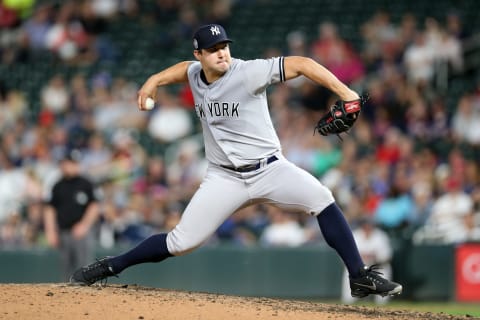
Jonathan Holder
Unlike some of his teammates, Holder isn’t known for being a dominant relief pitcher. Yet, it doesn’t mean he can’t stultify opposing hitters with some pitches in his repertoire.
While Holder barely pitched more than 100 innings during his first three MLB seasons, he showed he could be a staple in New York’s pen moving forward. He seems poised for a larger role in the pen though, at least as a middle reliever.
Surprisingly, one of the 25-year-old’s best pitch is one he developed just prior to last season – his slider. And like many of his fellow relievers on the Yankees, he’s shown stints of dominance because of it. But two of his other pitches are equally as effective.
Holder’s overall numbers improved dramatically as he gained more confidence in his fastball, slider, and changeup. He held hitters to a sub-.220 average and sub-.600 OPS with each pitch. He allowed just four home runs in more than 66 innings in 2018.
His swinging strike percentage for two of the three pitches mentioned are better than 10 percent. His fastball was once above the threshold, but it dipped a bit last season despite gaining velocity.
Arguably, his slider reigns supreme over his other pitches due to a higher swinging-strike rate and a lower batting average against. That could continue in 2019, or it could change since his other pitches are also efficient.
If Holder continues to pitch this well, he could be just another reliable mainstay in the Yankees’ bullpen. Yet, the small sample size must keep expectations realistic.
Holder has loads of potential, and few fans talk about him because he doesn’t rack up an immense amount of strikeouts compared to other New York relievers.
But he can become a sneaky, dependable guy throughout the upcoming season. And he would be yet another Yankees pitcher with a trusty slider.
Tommy Kahnle
Kahnle was relatively unknown until he 2017, when he pieced together an impressive run in Chicago prior to being dealt to New York. But last season was one the reliever hopes to forget.
He nearly allowed a run per inning pitched, sporting a 6.56 ERA overall with a bloated 1.63 WHIP. It wasn’t the first time fans saw him struggle in his career, but Yankees fans didn’t anticipate it when he arrived.
Nevertheless, Kahnle is presumably a new player this year, shedding weight in order to perform better in 2019. Thus far, it seems to be working.
But no matter how Kahnle prepares physically, he can still use his changeup to mystify hitters. And even though hitters fared well against the 29-year-old last season, they couldn’t hit his changeup.
Opponents boasted a paltry .105 average and .301 OPS against the off-speed pitch. In comparison, they raked off his fastball, owning a 1.176 OPS.
It’s curious to see how successful a pitcher does with one pitch, yet still throws the less-effective pitch more often. Of course, that is how it’s been for Kahnle since 2016.
Nonetheless, the New York reliever has an opportunity to re-join the bullpen this season and make a better impression. And it starts with his changeup.
Hitters own a .196/.243/.313 triple-slash against it in Kahnle’s career. And like Betances, Kahnle can use that pitch more than his heater, since it is more effective. Although, he could make his changeup even more valuable if hitters respect the fastball more.
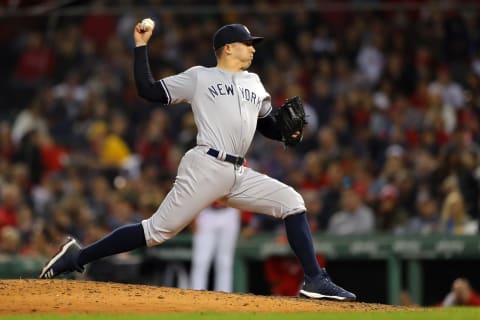
Chad Green
Relief pitchers are typically praised because of their blow-by fastball or a nasty breaking pitch. But there are some hurlers that make a name for themselves as a workhorse with pinpoint accuracy and control.
For the Yankees, Chad Green owns that title.
Granted, the right-hander can reach in the upper-90s with his heater. But he doesn’t have the firepower that his teammate Chapman boasts, though his fastball is arguably more effective.
Thus, Green relies on his fastball more than any other pitch in his arsenal. And so far, he’s had spectacular results, primarily during 2018.
Green made a name for himself throughout the 2017 campaign, boasting a minimized 1.83 ERA and magnificent 6.06 strikeout-to-walk ratio. While he didn’t punch out as many batters in 2018, he ultimately bettered that ratio in 2018.
More than 85 percent of the pitches Green threw last season were fastballs, exemplifying his confidence in it. Also, it is worth considering that Green’s slider wasn’t as effective last season, which means he may not throw it as much.
Most relief pitchers carry one pitch that flummoxes hitters frequently. Mariano Rivera relied on his cutter for the entirety of his career.
That may be the case for Green. But the Yankees likely won’t matter what Green depends on, as long as he continues to produce great results. If his fastball remains this effective, that shouldn’t be an issue.
Jordan Montgomery
It will be difficult for Yankees fans to be without Montgomery for possibly the entire first half of the season. After watching the southpaw in his first year with the club in 2017, fans gravitated toward him.
More importantly, fans across the league witnessed how Montgomery’s curveball puzzled hitters at the plate.
The lefty’s numbers from 2017 are intriguing and demonstrate just how essential his off-speed stuff is to his success. When looking at strikeouts, Montgomery registered just three with his sinker, which he threw 603 times.
He threw his curveball 655 times but accumulated 74 whiffs. He also allowed just nine walks via the curveball, which is impressive considering how often he threw it.
More importantly, opposing hitters were unable to garner several extra-base hits. In 2017, the Yankees starter allowed just eight of them, while in his abbreviated 2018 season, he yielded just one.
Opponents currently own a .476 OPS against Montgomery’s curveball, whereas their OPS against his sinker and fastball are both greater than .840.
It will be difficult for New Yorkers to have great expectations for the left-handed hurler, especially because he may not hold a rotation spot upon his return. He could replace whomever is injured at that time.
Nevertheless, as long as Montgomery’s curveball is intact, he can be a strong contributor, whether it be in Yankees’ bullpen or in the rotation.
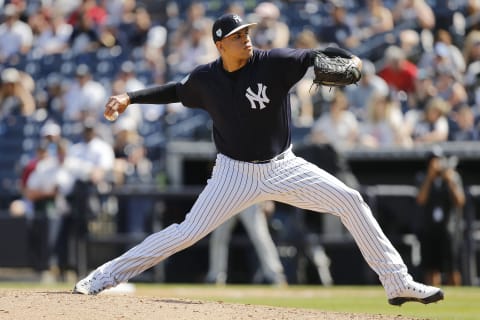
Adam Ottavino
The Yankees’ newest addition might pack the nastiest punch. If New York held a contest for the most outright effective pitch amongst its pitchers, Ottavino might be the victor.
While in Colorado, Ottavino made a name for himself, primarily in 2018 alone. Though he endured injury-riddled seasons, analysts dubbed him one of the most valuable relievers on the market this offseason.
There’s a legitimate reason for that. And it begins and ends with his slider.
The 33-year-old tossed relied more on his side-winding slider than any other pitch for six consecutive seasons. It’s essentially because opposing hitters own a paltry .186 average against it throughout Ottavino’s career, per FanGraphs.
New York sought the reliever because he keeps hitters off balance. His slider-sinker combination allows him to be successful.
Ottavino’s biting sinker acts more like his fastball. In fact, he struck more players out with his sinker than any other pitch last season.
But players have a more difficult time of making solid contact against the slider. Most are forced to pop out due to its movement. And hitters swing and miss against it more often than any other pitch – at least in his career.
There’s a reason Ottavino throws his slider so much. It’s one of the best pitches in the league.
Dellin Betances
The hard-throwing right-hander was once the best, most stable pitcher in the bullpen. Now, through he still excites the crowd with his off-speed stuff, he has lost a bit of his touch.
Most of the problems have been due to control, as Betances allowed too many walks the previous few seasons. But overall, he’s still been dominant in the Yankees pen, at least with his curveball.
The 30-year-old has become mildly dependent on the off-speed pitch since his ascension into a setup role in 2014. Since 2015, he’s thrown more curveballs than fastballs.
Despite throwing the same pitch for five seasons, opposing hitters are still mystified. Players own a .107 average against Betances’s curveball overall. Their OPS currently sits at .343.
Few of New York’s pitchers can boast about this much success garnered from one pitch. Possibly the most insane statistic is that just seven hitters have cracked a home run off the reliever’s curveball.
In more detail, seven of the 3,282 curveballs thrown have exited whatever baseball stadium the Yankees were in that day. Only a few other pitchers’ hangers acclaim that status of dominance, one being Clayton Kershaw.
Unless Betances becomes legitimately rattled for an extended period, that trend seems bound to continue. Since 2013, opponents haven’t posted a better OPS than .407.
Whether baseball fans want to admit it or not, Betances’s curveball is one of the nastiest, most effective pitches in the game.

Zack Britton
New York hasn’t witnessed much of Britton in pinstripes. Rather, Yankees fans have likely seen him at his best sporting black and orange, mowing down bombers in the Bronx.
But the southpaw will remain in New York for the next three years. While the former closer may not be as adept as he was in 2015, he can still make his opponents swing and miss.
Now, surpassing the 30-year-old mark, Britton could possibly likely implement more off-speed pitches into the equation. Nevertheless, he’s been a one-pitch reliever for most of his career thanks to his sinker’s effectiveness.
While Britton’s diving pitch doesn’t flummox hitters as well as Mariano Rivera’s cutter did during his tenure, it gets the job done. If it didn’t Britton wouldn’t throw it more than 90 percent of the time – what he’s done every year since 2014.
Opponents’ numbers against the sinker in 2016 were downright silly, as they owned a measly .406 OPS and earned just 35 hits – six for extra bases – in 213 at-bats.
Britton’s success hasn’t been as absurd in recent years, as hitters posted an OPS greater than .650 against his sinker in both 2017 and 2018.
Nevertheless, the left-hander is still a prime setup pitcher for the Yankees. However, he will have to adjust, as his velocity continues to dip with each consecutive season.
Whenever Britton is on the mound, it’s clear he will continue to maneuver his way around the American League’s best hitter with his breaking ball. At least, until it stops working for him.
Aroldis Chapman
When most Yankees fans watched the left-hander in action, they became infatuated with his 100-mph fastball. But hitters may finally be catching up to the heat.
Thus, analysts’ love for the hard stuff should be redirected to Chapman’s slider – his most effective pitch. His fastball works as the bread, his slider the butter.
But even throughout his career, the sidewinding off-speed pitch has caused more fits for opposing hitters. Also, Chapman has struggled with command of his heater more recently.
Opposing hitters have struggled against Chapman and all of his pitches. Yet, their .536 OPS against his fastball is much greater than their .353 OPS against his slider during his tenure.
Chapman’s slider was a key to his 2018 All-Star season, even though his numbers pale in comparison to what he posted during his prime in Cincinnati.
Hitters owned a sub-.300 OPS against the slider each consecutive season between 2012 and 2014. And it seemed that the lefty lost his touch in 2016 and 2017, as players roped his slider more consistently, even though it still resulted in an OPS below .600.
But the Cuban rebounded in 2018 with a more mystifying slider. Even though he threw nearly 400 fewer sliders than fastballs, he racked up more strikeouts with it.
It helped that the Yankees closer pitched better overall across the 2018 campaign. And when his fastball is at its peak, the slider is even more successful.
Fans should expect to see similar results in the upcoming season if Chapman’s slider is as effective as usual.
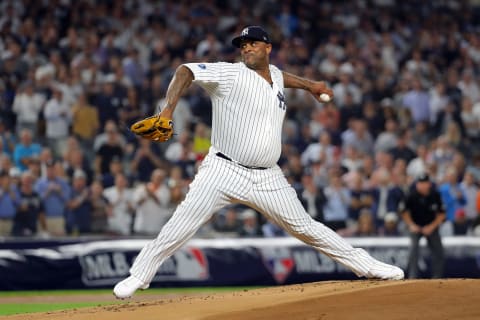
CC Sabathia
It seems that New York is always willing to give Sabathia one more year until the veteran decides to hang up his cleats – after this season. And the southpaw will likely occupy his back-end spot in the rotation this season once he returns from injury.
Fans may remember Sabathia in his prime, watching his slider break from one edge of the plate to the other, perplexing hitters frequently. Now, the 38-year-old no longer has a strong fastball, and his slider and cutter are sometimes indistinguishable now.
Still, the side-winding breaking ball has been more effective than any other pitch in his repertoire.
Sabathia’s slider was his go-to pitch during the first few seasons in his career. He racked up more than 130 strikeouts with it in 2008, 2011 and 2012. More recently, it’s been effective, but it hasn’t produced nearly as many whiffs.
Still hitters hit a medial .180 against it in 2017. They fared much better against it in 2018, boasting an OPS close to .760.
Nevertheless, Sabathia might rely on what made his career such a success in his final MLB season. It wouldn’t be surprising, given that opponents owned a combined .175/.210/.264 slash line against the slider thus far into his career.
The five-time All-Star now utilizes his cutter more than ever, throwing it more than any other pitch in each of the past three seasons. And it was his best pitch last year, leading to 60 of Sabathia’s 150 strikeouts.
Yet the cutter is typically used as his fastball, setting up hitters before he tosses his payoff pitch. At his career comes to a conclusion, Sabathia has a few more opportunities to showcase what made his career so successful – his slider.
J.A. Happ
The Yankees have seen a lot of Happ throughout the past few seasons – just not in pinstripes. But he performed well enough during his brief stint in the Bronx in 2018 to warrant a new contract.
Happ utilized different pitches to obtain success across the previous few seasons as well. But his confidence in his fastball surpasses his trust in throwing any other pitch.
And the results are noteworthy, as he threw more heaters in 2018 than any year since 2010. That also complemented the trend of relying less on his curveball, which used to be a go-to payoff pitch.
Unlike most pitchers whose velocity dwindles as they get older, Happ’s speed has remained relatively consistent. Between 2013 and 2018, his fastball sat between 92 and 93.5 on average each year.
Hitters haven’t been able to adjust considerably to it either, as they hit .200 and .203 against it in two of the last three seasons.
(Happ’s fastballs thrown/all pitches thrown)
2014: 1,430/2,707 (51.8 percent)
2015: 1,548/2,821 (54.8 percent)
2016: 1,379/3,032 (45.5 percent)
2017: 1,050/2,484 (42.2 percent)
2018: 1,804/3,049 (59.1 percent)
While Happ seemed to lose his confidence in his heater, he regained it last year, as seen by his splits. He seems poised to use it often once again during this season, though it’s unknown whether hitters will fare better against it.
The left-hander has made it this far in his career with the weapons he has. It wouldn’t be surprising to see him continue his consistency in 2019 while still relying on his fastball.
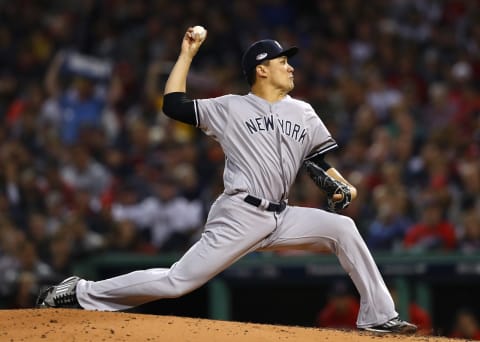
Masahiro Tanaka
As the team’s current Opening Day starter, Tanaka has had an interesting career in pinstripes so far. The former Japanese star was acclaimed to be the next Yankees great on the mound when they signed him in .
Instead, Tanaka has been a relatively consistent No. 3 starter. Nevertheless, he focuses on his off-speed arsenal, primarily his slider and splitter.
Yet since Tanaka moved to the United States, both have been almost equally effective. But it makes sense that he throws his slider more than anything else.
Hitters’ numbers against Tanaka’s splitter and slider are almost indistinguishable in some aspects. He garnered more strikeouts via his splitter, but he also yielded more hits with it. Meanwhile, hitters own a slightly lower average against his slider overall.
That trend was evident in both 2017 and 2018, and opponents also owned a lower OPS against the slider. Of course, hitters still struggled mightily against the splitter in those seasons too.
The one advantage of tossing the splitter is that it induces more ground balls. At least, that happened about 67 percent and 59 percent of the time in 2017 and 2018, respectively. In Yankees Stadium, it’s important to keep the ball out of the air.
However, Tanaka’s splitter didn’t miss as many bats last season and prior years. Hitters increased their line-drive percentage by nearly nine percent, which makes a difference.
Yankees fans will see plenty of splitters and sliders throughout the year, and it’s unknown which will be more perplexing. But if Tanaka has a crucial situation, it seems likely that he’d rely on the slider to get the job accomplished.
James Paxton
Expectations are high for the Canadian southpaw as he enters his first season in the Bronx. But fans that are aware of Paxton’s recent dominance understand he will thrive as long as he remains healthy.
The Canadian star claimed he will not be satisfied until he tosses an 81-pitch perfect game with 27 strikeouts. While that is a wholly improbable goal to achieve, the southpaw still possesses a repertoire that allows him to amass several strikeouts per game.
Paxton tossed a no hitter in 2018, which certainly attests to how effective his pitches can be. The left-hander also ranked fourth in strikeouts per nine innings among starters with more than 160 innings pitched.
Yet, the left-hander might not be as efficient on the bump without his cutter, which has ultimately become his most dangerous pitch.
More from Call to the Pen
- Philadelphia Phillies, ready for a stretch run, bomb St. Louis Cardinals
- Philadelphia Phillies: The 4 players on the franchise’s Mount Rushmore
- Boston Red Sox fans should be upset over Mookie Betts’ comment
- Analyzing the Boston Red Sox trade for Dave Henderson and Spike Owen
- 2023 MLB postseason likely to have a strange look without Yankees, Red Sox, Cardinals
Since 2015, Paxton has thrown 3,665 more fastballs than cutters during his outings. Yet, in that span, the southpaw has just 60 more punch-outs with his fastball than his cutter.
Thus, it’s evident that the 30-year-old has confidence in the hard-biting pitch. And that was proven in 2018, which is when his cutter was arguably most effective in his career.
Opponents posted a measly .424 OPS against Paxton’s cutter. Also, it led to a swinging-strike percentage of 22 percent. During his career, he’s held hitters to a .167 average overall, which is impressive.
If Paxton can continue this sort of dominance with his main pitch, he will surely fit in well with the Yankees.
Luis Severino
The young starter has made significant strides since his sophomore slump. While he still has some improvements to make, he has claimed his status atop the New York rotation.
Fans won’t likely see the 25-year-old until May. But when they do, they will be able to watch him twirl scoreless innings with his slider.
As a rookie in 2015, it seemed Severino primarily was a two-pitch guy with a fastball-slider combo. But he developed his changeup in 2017 and 2018, tossing it more than 400 times with some success.
Still, the Yankees ace racks up more whiffs and strikeouts with the slider. And hitters have posted a meager sub-.200 average against it throughout Severino’s career.
His slider’s swinging-strike percentage is nearly double that of his fastball. Surely, an off-speed pitch is more elusive than a fastball, but it explains why the former Cy Young candidate has much confidence in his off-speed repertoire.
More impressively, Severino’s control of his slider helps with his success. He only has a four percent walk rate, compared to nearly and eight-and-a-half and eight percent rate for his fastball and changeup, respectively.
But there is still some improvement needed to be made. Hitters had more fly balls against the slider in 2018 than in 2017, though it didn’t directly lead to more home runs hit. Yet, it can be more dangerous to see balls hit in the air.
Next. Will the Yankees fail if they don't win the World Series?. dark
Once Severino returns to New York, that could be one adjustment he works on this year. Nevertheless, Yankees fans will be happy to see the age healthy with his effective slider working against opposing hitters.